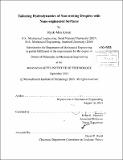| dc.contributor.advisor | Kripa K. Varanasi. | en_US |
| dc.contributor.author | Kwon, Hyuk-Min | en_US |
| dc.contributor.other | Massachusetts Institute of Technology. Department of Mechanical Engineering. | en_US |
| dc.date.accessioned | 2014-03-06T15:43:12Z | |
| dc.date.available | 2014-03-06T15:43:12Z | |
| dc.date.copyright | 2013 | en_US |
| dc.date.issued | 2013 | en_US |
| dc.identifier.uri | http://hdl.handle.net/1721.1/85455 | |
| dc.description | Thesis: Ph. D., Massachusetts Institute of Technology, Department of Mechanical Engineering, 2013. | en_US |
| dc.description | Cataloged from PDF version of thesis. | en_US |
| dc.description | Includes bibliographical references (pages 47-53). | en_US |
| dc.description.abstract | Considering that contacts between liquid and solid are ubiquitous in almost all energy processes, including steam turbines, oil pumping, condensers and boilers, the efficiency of energy transportation can be maximized such that the liquid-solid interaction is optimized. Texture based super-hydrophobicity, also known as the Lotus effect, has been one of the most extensively studied topics in the last decade. Many of the recent studies have focused on how textures induce more water repellency, and how these textures can be manufactured with different methods and materials. However, few studies have shown how these surfaces benefit the real energy processes in which the interaction between liquid droplets and solid surfaces is vigorous and influences the energy transfer performances. This work focuses on altering the hydrodynamics of droplets with nano-engineered surfaces such that it enables a variety of energy transport processes to achieve better efficiency. Firstly, the wetting transition on textured super-hydrophobic surfaces is explored. The careful investigation of Cassie-Baxter to Wenzel transition of a pendant drop during the deposition explains that the rapid deceleration-induced water hammer pressure causes the transition. This new transition mechanism for large droplets enables a new wetting transition phase diagram with a previously known Laplace mechanism that explains the small drop transition. Another class of non-wetting droplet, the Leidenfrost drop, is studied with textured super-wetting surfaces. The liquid drop loses its contact to the solid by its own vapor, created by a large superheat from the solid. The Leidenfrost effect is undesirable in cooling applications as the vapor layer acts as a barrier for heat transfer. Here, it has been studied that how textured super-hydrophilic surfaces induce droplets to wet at higher superheat via capillary wicking compare to smooth surfaces. A physical model based on scaling is developed to predict the Leidenfrost drop on single length scale textures, and validated by the experiments. Additionally, the physical mechanism suggests that hierarchical textures have a higher Leidenfrost temperature compared to single-length-scale textures, confirmed experimentally. Lastly, the recently discovered rare-earth oxide ceramics are studied, which ensures the benefits of water repellency under harsh conditions such as high temperature and abrasive wear. Texturing of the rare-earth oxide ceramic is explored by the laser ablation technique. Unique micro- and nano-scale hierarchical textures are created, enhancing the water repellency, resulting in the super-hydrophobic rare-earth ceramic. | en_US |
| dc.description.statementofresponsibility | by Hyuk-Min Kwon. | en_US |
| dc.format.extent | 53 pages | en_US |
| dc.language.iso | eng | en_US |
| dc.publisher | Massachusetts Institute of Technology | en_US |
| dc.rights | M.I.T. theses are protected by copyright. They may be viewed from this source for any purpose, but reproduction or distribution in any format is prohibited without written permission. See provided URL for inquiries about permission. | en_US |
| dc.rights.uri | http://dspace.mit.edu/handle/1721.1/7582 | en_US |
| dc.subject | Mechanical Engineering. | en_US |
| dc.title | Tailoring hydrodynamics of non-wetting droplets with nano-engineered surfaces | en_US |
| dc.type | Thesis | en_US |
| dc.description.degree | Ph. D. | en_US |
| dc.contributor.department | Massachusetts Institute of Technology. Department of Mechanical Engineering | |
| dc.identifier.oclc | 870967819 | en_US |
